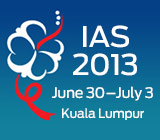 The World Health Organization (WHO) has revised its treatment guidelines for people living with HIV worldwide, recommending they begin antiretroviral (ARV) therapy when their CD4 count hits 500 or below, as opposed to the previous benchmark of 350, The New York Times reports. WHO released the new guidelines on the opening day of the International AIDS Society 2013 conference in Kuala Lumpur.
The World Health Organization (WHO) has revised its treatment guidelines for people living with HIV worldwide, recommending they begin antiretroviral (ARV) therapy when their CD4 count hits 500 or below, as opposed to the previous benchmark of 350, The New York Times reports. WHO released the new guidelines on the opening day of the International AIDS Society 2013 conference in Kuala Lumpur.
WHO also recommended that various subgroups of HIV-positive people receive ARVs regardless of CD4 count, including all children younger than 5, all pregnant and nursing women, and anyone in an ongoing relationship with an HIV-negative partner. The agency continues to advise that all of those who are HIV positive and living with active tuberculosis (TB) or with hepatitis B virus (HBV) receive ARVs.
A further recommendation is that all adults should begin treatment with a once-a-day, single pill combination therapy containing Viread (tenofovir), Sustiva (efavirenz) and either Epivir (lamivudine) or Emtriva (emtricitabine). (Atripla contains tenofovir, efavirenz and emtricitabine; a generic-based version of the combo uses lamivudine instead of emtricitabine—the two meds operate similarly—and has received tentative approval by the FDA.)
The new guidelines will extend drug eligibility from the current 17 million to 26 million people in poor and middle-income countries. WHO estimates that nearly 10 million people are currently receiving ARVs worldwide, out of a total 34 million living with the virus.
WHO projects that the new guidelines could prevent an additional 3 million deaths as well as 3.5 million new infections by 2025.
To read the Times story, click here.
To read the WHO release, click here.
Advertisement
Advertisement
Advertisement






Comments
Comments